The Durable Goods, advance report shows new orders decreased by -2.0% for October 2013 after a 4.1% increase in September. The decline was mainly aircraft as transportation durable goods new orders by themselves dropped -5.9%. Without transportation orders, which aircraft is a large part, durable goods new orders fell by -0.1%. We also estimate Q3 GDP will be revised upward to 3.2% on inventories.
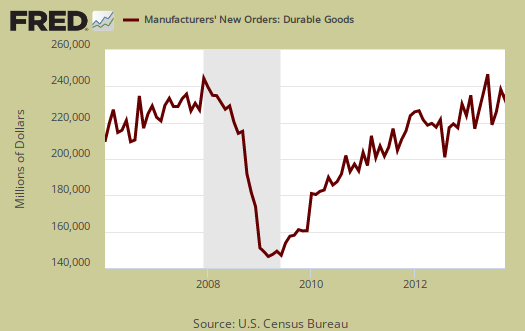
Below is a graph of all transportation equipment new orders, which declined by -5.9% for the month. Motor vehicles & parts actually increased by 1.7%. Aircraft and parts new orders from the non-defense sector decreased -15.9%. Aircraft & parts from the defense sector declined by -20.0%. Aircraft orders are notoriously volatile, each order is worth millions if not billions, and as a result aircraft manufacturing can skew durable goods new orders on a monthly comparison basis.
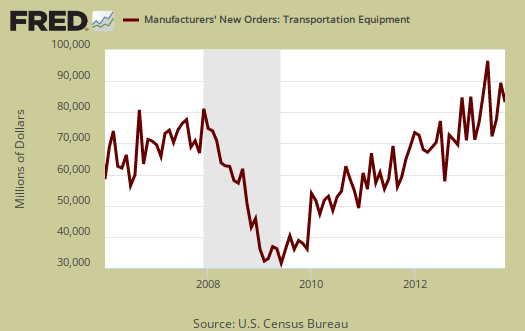
Core capital goods new orders declined by -1.2% for October and September saw a -1.4% change. This implies a slowing of economic activity. Core capital goods is an investment gauge for the bet the private sector is placing on America's future economic growth and excludes aircraft & parts and defense capital goods. Capital goods are things like machinery for factories, measurement equipment, truck fleets, computers and so on. Capital goods are basically the investment types of products one needs to run a business. and often big ticket items. A decline in new orders indicates businesses are not reinvesting in themselves. Machinery by itself showed a -0.3% drop in new orders in October and a -2.0% change in September.
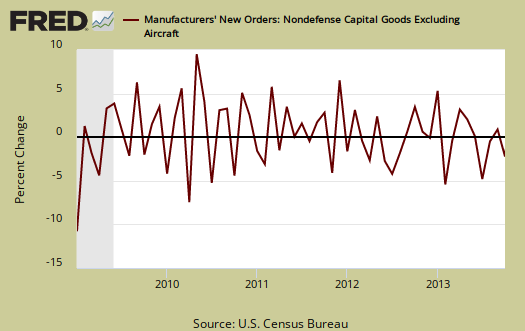
To put the monthly percentage change in perspective, below is the graph of core capital goods new orders, monthly percentage change going back to 2000. Looks like noise right? We use so many graphs to amplify trends for one month of data does not an economy make.
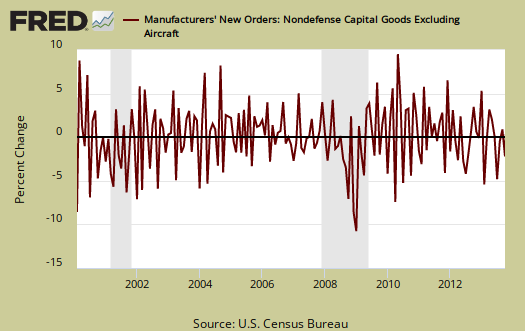
Shipments overall increased 0.2% after a 0.5% increase in September and bear in mind new orders are not necessarily shipped the next month an order is made. Below is the monthly shipments; percent change for all durable goods shipments.

Shipments in core capital goods decreased -0.2%, the same as September. The below graph goes back to 1990 to show how core capital goods shipments tracks recessions, the gray bars in the graph.
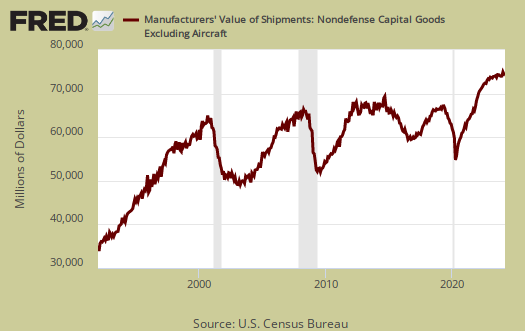
Inventories, which also contributes to GDP, increased 0.3% after increasing 0.8% for September. Graphed below are total durable goods inventories monthly figures.
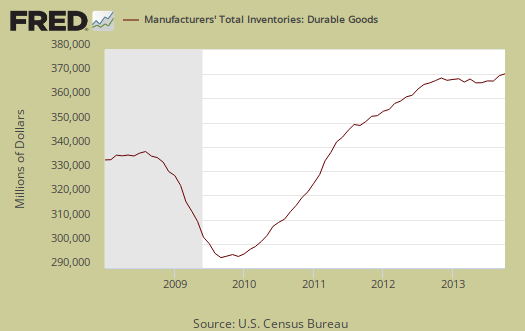
We expect Q3 GDP to be revised upward. Wholesale and retail inventories minus equipment and motor vehicles and parts were released after the advanced GDP report. We've number crunched the actual figures versus the BEA inventory assumptions and come up with a 1.4 percent point contribution to GDP for changes in private inventories, nonfarm, from the original 0.71 nonfarm changes in private inventories percentage point contribution. That is a 0.7 percentage point revision upward although we expect the trade deficit to in term lower Q3 GDP by 0.3 percentage points. This puts our guesstimate for Q3 GDP to be 3.2%, from the original 2.8% Q3 GDP advance estimate.
Core Capital Goods inventories increased 0.1% for the month. September saw a 0.4% increase while August and July showed declines in core capital goods inventories. Graphed below are quarterly core capital goods inventories annualized percentage change and for Q3 was 11.0%. In Q2 this value was -2.2% In other words, this implies the durable goods manufacturing inventory component to GDP should be much improved and will revisions should increase Q3 GDP, unlike shipments shown below.
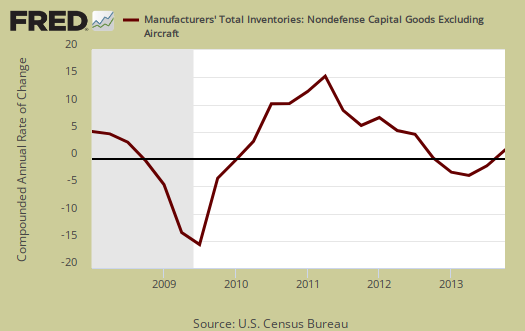
Core shipments contributes to the investment component of GDP. Producer's Durable Equipment (PDE) is part of the GDP investment metric, the I in GDP or nonresidential fixed investment. It is not all, but part of the total investment categories for GDP, usually contributing about 50% to the total investment metric (except recently where inventories have been the dominant factor). Producer's Durable Equipment (PDE) is about 75%, or 3/4th of the durable goods core capital goods shipments, in real dollars, used as an approximation. Below is the national accounts description of PDE:
Nonresidential PDE consists of private business purchases on capital account of new machinery, equipment such as furniture, and vehicles (except for personal-use portions of equipment purchased for both business and personal use, which are included in PCE), dealers' margins on sales of used equipment, and net purchases of used equipment from government agencies, from persons, and from the rest of the world.
The below graph might give a feel for what kind of investment component we might see on PDE for Q3 2013 GDP as well as Q4.  This is the monthly percentage change of nominal values, not real, not adjusted for inflation, for core capital goods shipments. nbsp;This implies Q3 GDP investment component will be low as core capital goods shipments declined at an annualized -2.1% rate for Q3 2013 although the revision should help revise Q3 GDP up just very slightly as the investment equipment component took -0.21 percentage points from real Q3 GDP with an annualized -2.9% nominal rate change. For the start of Q4, this isn't good news and unless there is a rebound in the next two months, the -0.2% core shipments decline implies a negative equipment investment contribution to Q4 GDP.

More interesting the report excludes semiconductor manufacturing and we must wonder if that means it is non-existent since so much has been offshore outsourced and thus corporations don't want the public to figure that fact out.
What is a durable good? It's stuff manufactured that's supposed to last at least 3 years. Here are our durable goods, related overviews, only some graphs revised. The durable goods advance report is often revised when the full factory orders statistics are released.

Recent comments